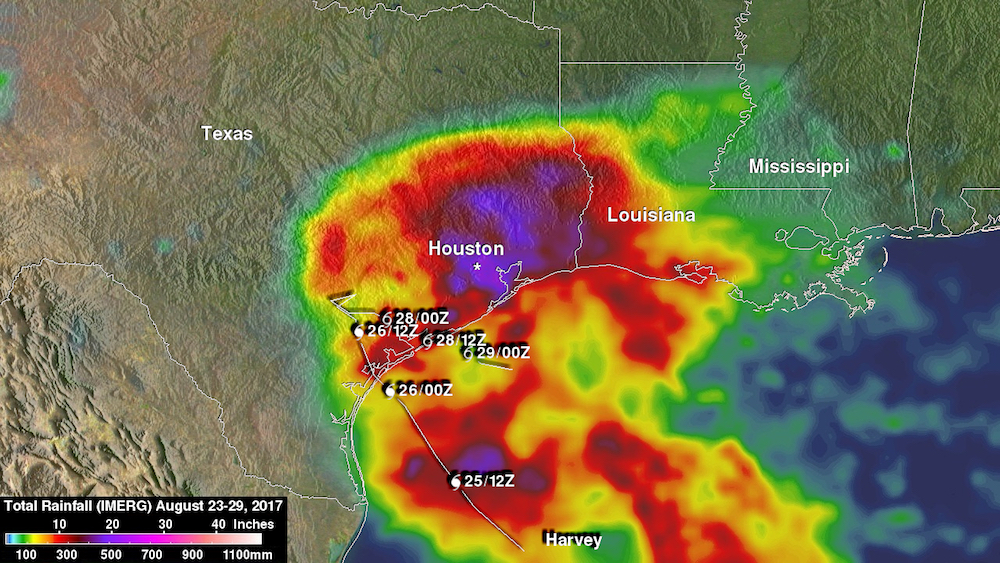Did Climate Change Intensify Harvey's Catastrophic Effects?

Astonishing, unprecedented, catastrophic: Experts are running out of adjectives to describe the devastation Tropical Storm Harvey has unleashed as it has relentlessly dumped more than 40 inches (102 centimeters) of rain on the Houston area, setting an all-time record for a tropical system in the contiguous U.S.
Harvey has been exceptional in a number of ways since it quickly spun up from a bedraggled collection of storms in the Gulf of Mexico before slamming into the coast of Texas as a Category 4 hurricane — the first major hurricane to strike the U.S. since 2005 and the first hurricane to hit Texas since 2008. But nothing compares to the epic amounts of rain that have left even experienced meteorologists and emergency workers astounded. [In Photos: Hurricane Harvey Takes Aim at Texas]
A number of factors contributed to the historic nature of this storm — most likely including climate change, experts say. But breaking down what role global warming plays in any individual storm is still a difficult question that doesn't yield easy answers.
The clearest link is likely with extreme rainfall, several scientists said, as heavy precipitation events have been on the rise in recent decades and several have been shown to be more likely because of climate change. But even there, the peculiar weather setup of Harvey was the biggest driver, the scientists said.
"It's important to say that this event — or something close to it — could have happened without climate change," Adam Sobel, who directs Columbia University's Initiative on Extreme Weather and Climate, told Live Science. But climate change could have played a role, even if only a minor one, experts said, and the science is constantly improving to detect that influence.
Harvey's rapid rise
Harvey traversed the Caribbean as a tropical storm early last week, but shearing winds tore it apart. It was reborn from those remnants as they emerged back into the Gulf of Mexico and encountered favorable wind conditions and a pool of warm water, Jim Kossin, an atmospheric research scientist at the University of Wisconsin-Madison and the National Centers for Environmental Information (NCEI), told Live Science. "The environment most definitely was conducive."
It so conducive, in fact, that an index used to forecast the potential for storms to rapidly spin up was at an unusually high level for the Atlantic basin, Phil Klotzbach, a hurricane expert at Colorado State University, said. [A History of Destruction: 8 Great Hurricanes]
Breaking space news, the latest updates on rocket launches, skywatching events and more!
Harvey fairly quickly went from a tropical storm to a Category 4 hurricane with winds of 130 mph (209 km/h). (After landfall, it slowly weakened into a tropical storm again.)
Over the last decade, research into the potential impacts of climate change on hurricanes was spurred by Katrina, and scientists have determined that warming, particularly of the oceans, is likely to lead to more of the most intense hurricanes, even if there are fewer storms overall.
But there isn't clear evidence that such a shift is already happening, in part because researchers detect more storms now than they did before the advent of satellites and the ways they measure hurricane intensity have changed, said Gabriel Vecchi, a Princeton University climate scientist. Any trend toward more-intense storms may also be too small to stand out against the big year-to-year swings in hurricane activity he said.
"Even though we expect that the intensity of storms should be fueled by global warming, it's really tough to say that that's already happening," Vecchi told Live Science.
How warming might affect the rapid intensification of storms is a little trickier to answer, as there are still aspects of the process that scientists don't fully understand, Klotzbach said. Ocean warming could tilt the odds in favor of more rapid intensification in the future, because warm oceans provide the fuel for that process, Kossin said. Warming is also increasing the difference in temperature between different layers of the atmosphere, which is raising the bar on the intensity any particular storm can achieve, he said, and this could favor more-rapid intensification.
Clearest climate link
The strongest link between Harvey and climate change, though, is likely seen in its astronomical rainfall, several scientists said. Over the five days from Aug. 24 to Aug. 29, Houston more than doubled its rainfall total for the year to date, according to rain data from Houston's William P. Hobby Airport. And Harvey broke the all-time record for total rainfall from a tropical system in the contiguous U.S., dropping 49.2 inches (125 cm) at Mary's Creek at Winding Road in southeast Houston, according to the National Weather Service. (The previous was record was 48 inches, or 123 cm.)
One of the clearest outcomes of global warming is that the amount of moisture in the atmosphere increases as temperatures rise, meaning more fuel for rainstorms. [Hurricanes from Above: Images of Nature's Biggest Storms]
The main reason Harvey has been racking up rainfall records day after day, though, is that it just hasn't moved much since making landfall. Its average speed has been a plodding 3 mph (4.8 km/h), Klotzbach noted on Twitter. High-pressure systems to the east and west of Harvey have kept the storm blocked in, and so rain bands have been dumping over the same area over and over again.
"If storms don't move, they cause a lot of damage," Klotzbach said.
And it's not clear whether this kind of stalled-out storm situation would be more or less common with warming, Vecchi and others said. But because of that added moisture boost from warming, when such a stalling does happen, the rains will be higher, even if only by a relatively small amount.
"And given the enormous cost of this storm in human life and property and everything else, the extra costs due to that amplification may be significant, even if it's a small fraction of the total," Sobel said.
Looking for human fingerprints
To say anything specific about how and whether climate change affected Harvey, "we definitely would want to do a formal detection and attribution study," Kossin said.
Such studies use climate models and observational records to look for the fingerprints of climate change on extreme weather and have been done for dozens of events, ranging from heat waves to snowstorms.
Doing such a study for a hurricane is much more difficult than for a heat wave, though, because hurricanes are far more complex. An attribution study would require high-resolution models that are currently too expensive and time-consuming to run. But Vecchi said he is optimistic that such tools could be in place in a decade.
Kossin, who co-edits an annual attribution edition of the Bulletin of the American Meteorological Society, said he hopes that research groups will look at Harvey for next year's edition.
Any such study is likely to focus on the storm's rainfall, though even then, the picture is somewhat complex, because climate change may change air patterns that govern when, where and how weather forms, not just the moisture available for a storm, Friederike Otto, a University of Oxford climate scientist involved in attribution work, wrote at Climate Home. And those changing air patterns could actually make heavy rains less likely, she said.
But an attribution study of last year's torrential rains in central Louisiana found a clear climate change signal, so "I would suspect that if somebody did a formal attribution study [of Harvey], that's where I would expect to see a human fingerprint, is the rainfall," Vecchi said.
Sarah Puschmann contributed reporting.
Original article on Live Science.

Andrea Thompson is an associate editor at Scientific American, where she covers sustainability, energy and the environment. Prior to that, she was a senior writer covering climate science at Climate Central and a reporter and editor at Live Science, where she primarily covered Earth science and the environment. She holds a graduate degree in science health and environmental reporting from New York University, as well as a bachelor of science and and masters of science in atmospheric chemistry from the Georgia Institute of Technology.


